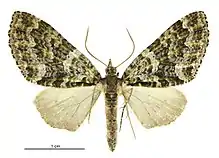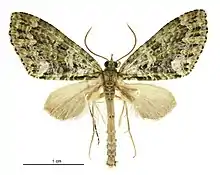Tatosoma agrionata
Tatosoma agrionata is a species of moth in the family Geometridae first described by Francis Walker in 1862. It is endemic to New Zealand. It is classified as at risk, declining by the Department of Conservation.
| Tatosoma agrionata | |
|---|---|
 | |
| Female | |
 | |
| Male | |
| Scientific classification | |
| Kingdom: | |
| Phylum: | |
| Class: | |
| Order: | |
| Family: | |
| Genus: | |
| Species: | T. agrionata |
| Binomial name | |
| Tatosoma agrionata | |
| Synonyms[2] | |
| |
Taxonomy
T. agrionata was first described by Francis Walker in 1862 using specimens collected either in Hawke Bay or Taupo by William Colenso.[2] Walker originally named the species Cidaria agrionata.[2][3] In the same publication Walker, thinking it was a separate species, again described the moth under the name Cidaria collectaria.[2][4] In 1988 John S. Dugdale synonymised this name.[2] George Vernon Hudson discussed and illustrated this species in his 1928 book The Butterflies and Moths of New Zealand.[5] The lectotype specimen is held in the Natural History Museum, London.[2]
Description
The larvae of this species are orange upon hatching but as they mature they turn yellow green.[6] They are slightly paler on their underside.[6] When mature they form a cocoon from soil and silk on the surface of the ground underneath their host plants.[6]
Hudson described the adults of the species as follows:
The expansion of the wings of the male is 1 1⁄4 inches; of the female 1 3⁄8 inches. On the forewings the green colouring is more or less confined to the neighbourhood of the veins and is much less pronounced than in T. tipulata; the basal and subterminal areas are transversed by several narrow cream-coloured bands, which are especially evident in the male, and the black markings are more extensive and slightly tinged with dull reddish. The abdomen of the male is considerably shorter than in the same sex of T. tipulata and the anal lope of the hind-wings nearly twice as large.[5]
T. agrionata is very similar in appearance to Tatosoma tipulata and can be confused with that species.[5]
Distribution
This species is endemic to New Zealand.[1][7] It has occurred from the Bay of Plenty to Wellington in the North Island and from Nelson to Stewart Island.[8] However, this species is now possibly extinct in the North Island.[8]
Life cycle and behaviour
Larvae of T. agrionata are slow moving.[6] Adults emerge from July to May and it has been hypothesised that there are two generations per year.[6] The adults of this species can be looked for resting on tree trunks.[5]
Habitat and host plants
_Tiegh._(AM_AK343668-7).jpg.webp)
T. agrionata frequents forest habitat and can be found up to an elevation of 900 m.[5][6] The host species for the larvae of this species are native leafy Loranthaceae such as Alepis flavida, Ileostylus micranthus, Peraxilla colenso, Peraxilla tetrapetala, Trilepidea adamsii and Tupeia antarctica.[8][9][10]
Conservation status
This moth is classified under the New Zealand Threat Classification System as being at risk, declining.[11]
References
| Wikimedia Commons has media related to Tatosoma agrionata. |
- "Tatosoma agrionata (Walker, 1862)". New Zealand Organisms Register. Landcare Research New Zealand Ltd. Retrieved 15 May 2018.
- Dugdale, J. S. (1988). "Lepidoptera-annotated catalogue, and keys to family-group taxa" (PDF). Fauna of New Zealand. 14: 190 – via Landcare Research New Zealand Ltd.
- Walker, Francis (1862). "XXV: Geometrites (continued)". List of the Specimens of Lepidopterous Insects in the Collection of the British Museum. pt. 25: 1281–1477 – via Biodiversity Heritage Library.
- Walker, Francis (1862). "XXV: Geometrites (continued)". List of the Specimens of Lepidopterous Insects in the Collection of the British Museum. pt. 25: 1281–1477 – via Biodiversity Heritage Library.
- Hudson, G. V. (1928). The Butterflies and Moths of New Zealand. Wellington: Ferguson & Osborn Ltd. p. 85.
- De Lange, Peter J.; Norton, David A., eds. (1997). New Zealand's Loranthaceous Mistletoes: Proceedings of a Workshop Hosted by Threatened Species Unit, Department of Conservation, Cass, 17 -20 July 1995. Wellington, N.Z.: Department of Conservation, New Zealand. ISBN 0478019068. OCLC 154315406.
- Gordon, Dennis P., ed. (2010). New Zealand Inventory of Biodiversity. Volume Two. Kingdom Animalia: Chaetognatha, Ecdysozoa, Ichnofossils. Vol. 2. Christchurch, N.Z.: Canterbury University Press. p. 460. ISBN 9781877257933. OCLC 973607714.
- Patrick, Brian; Dugdale, John S. (2000). Conservation Status of the New Zealand Lepidoptera (PDF). Wellington, N.Z.: Department of Conservation, New Zealand. p. 32. ISBN 0478218672. OCLC 154670803.
- "Leafy mistletoes | New Zealand Plant Conservation Network". New Zealand Plant Conservation Network. 14 December 2013. Retrieved 14 May 2018.
- Patrick, H.; Bowie, M.; Fox, B.; Patrick, B. (2011). "The moths of Quail Island (Ōtamahua): a faunal comparison of an island under restoration with other sites on Banks Peninsula" (PDF). New Zealand Natural Sciences. 36: 57–72. Retrieved 15 May 2018.
- Hoare, R.J.B.; Dugdale, J.S.; Edwards, E.D.; Gibbs, G.W.; Patrick, B.H.; Hitchmough, R.A.; Rolfe, J.R. (2017). Conservation Status of New Zealand Butterflies and Moths (Lepidoptera), 2015 (PDF). Wellington, New Zealand: New Zealand Department of Conservation. p. 7. ISBN 9781988514383.